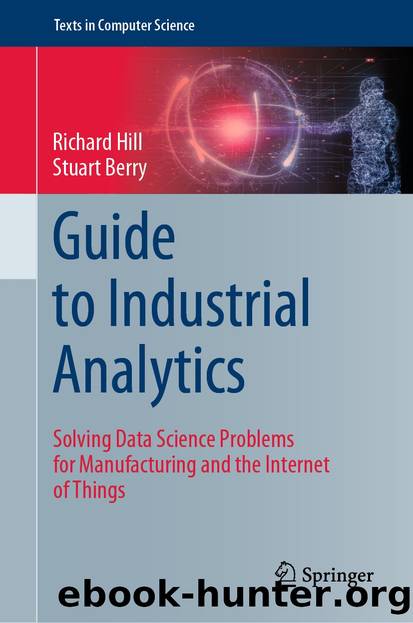Guide to Industrial Analytics by Richard Hill & Stuart Berry

Author:Richard Hill & Stuart Berry
Language: eng
Format: epub
ISBN: 9783030791049
Publisher: Springer International Publishing
© Springer Nature Switzerland AG 2021
R. Hill, S. BerryGuide to Industrial AnalyticsTexts in Computer Sciencehttps://doi.org/10.1007/978-3-030-79104-9_6
6. From Process to System Simulation
Richard Hill1 and Stuart Berry2
(1)Department of Computer Science, University of Huddersfield, Huddersfield, UK
(2)Department of Computing and Mathematics, University of Derby, Derby, UK
Richard Hill
Email: [email protected]
6.1 Simulating Industrial Systems
In the previous chapter we looked at the concept of queueing as an industrial process. Queues are an effective way of representing dynamic systems that receive an input, process that input and then produce an output. As such, they lend themselves to the modelling of processes or services within organisations.
When we are faced with a complex problem to be solved, we often try and simplify the representation of the object or system under scrutiny. We can look at a situation in the most abstract way possible, or we can delve deep into the system and model one tiny aspect of it in great detail.
For example, we could model an entire business with just one queue; the business would take in orders, process those orders, and we could produce a set of results using a simulation like we built in the previous chapter.
This scenario might work, in that if the order mix and the demand patterns were stable and the production processes were relatively predictable, a one-queue model would suffice. It would be limited in what it could tell us though, as there would not be a sufficient number of variables to experiment with. In the real-world, modelling an entire business as a single queue is somewhat similar to the high-level analysis that an accountant could perform with a set of spreadsheets.
We tend to be motivated to model and simulate an organisation when we feel the need to understand it better. Modelling the organisation as a set of queues is a good way of achieving improved understanding. The process of modelling itself is often enlightening, as are the questions that it prompts us to ask production personnel as we build the model.
Queues therefore allow us to model a system at different levels, and this leads to a range of opportunities to comprehend what is going on in an organisation.
Rather than abstracting the business as one queue, we could look at divisions, sections or departments, depending on how the business is subdivided. Problems often provide the impetus for improvement, and that improvement usually requires more scrutiny than we can currently perform.
Therefore, the focus of your modelling may be a particular âproblemâ process; the machining centre that cannot keep up with the rest of the factory, or the sales order processing clerk who always seems to be behind.
Queues do enable a modular approach to improve the visibility we have of a business. We can take a top-down approach where we partition the business broadly into functions that we model as separate queues. Or, we can select individual processes that we want to look at in more detail.
All of the above requires us to extend the one-queue approach to modelling of the previous chapter, so that we can look at collections of queues, both individually and as a whole.
Download
This site does not store any files on its server. We only index and link to content provided by other sites. Please contact the content providers to delete copyright contents if any and email us, we'll remove relevant links or contents immediately.
| Automotive | Engineering |
| Transportation |
Whiskies Galore by Ian Buxton(41524)
Introduction to Aircraft Design (Cambridge Aerospace Series) by John P. Fielding(32881)
Small Unmanned Fixed-wing Aircraft Design by Andrew J. Keane Andras Sobester James P. Scanlan & András Sóbester & James P. Scanlan(32567)
Craft Beer for the Homebrewer by Michael Agnew(17926)
Turbulence by E. J. Noyes(7690)
The Complete Stick Figure Physics Tutorials by Allen Sarah(7134)
Kaplan MCAT General Chemistry Review by Kaplan(6584)
The Thirst by Nesbo Jo(6431)
Bad Blood by John Carreyrou(6270)
Modelling of Convective Heat and Mass Transfer in Rotating Flows by Igor V. Shevchuk(6218)
Learning SQL by Alan Beaulieu(6023)
Weapons of Math Destruction by Cathy O'Neil(5818)
Man-made Catastrophes and Risk Information Concealment by Dmitry Chernov & Didier Sornette(5638)
Digital Minimalism by Cal Newport;(5382)
Life 3.0: Being Human in the Age of Artificial Intelligence by Tegmark Max(5181)
iGen by Jean M. Twenge(5149)
Secrets of Antigravity Propulsion: Tesla, UFOs, and Classified Aerospace Technology by Ph.D. Paul A. Laviolette(4973)
Design of Trajectory Optimization Approach for Space Maneuver Vehicle Skip Entry Problems by Runqi Chai & Al Savvaris & Antonios Tsourdos & Senchun Chai(4837)
Electronic Devices & Circuits by Jacob Millman & Christos C. Halkias(4739)
